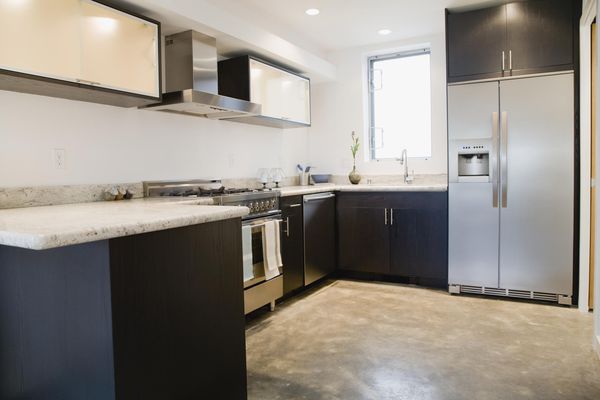Electrical circuits for kitchen
IThe kitchen is the room that uses the most electricity in the home, and for this reason, it requires several electrical circuits. While a bedroom or other room may be served only by a standard lighting circuit that provides all the power for lights and plug-in devices, it's not uncommon for a kitchen to have five or six circuits, or even more if there are many hardwired electrical appliances.
Here is a list of the most commonly used circuits in a kitchen.
01 of 07
Refrigerator
Modern domestic kitchen
Inti St Clair/Photodisc/Getty Images
As we get larger and larger appliances, the load demand increases in our homes. A modern refrigerator requires a dedicated 20-amp, 120/125-volt circuit. You may currently have a smaller refrigerator plugged into a general lighting circuit, but during any major remodeling, a dedicated 120/125-volt circuit should be installed.
For this dedicated 20-amp circuit, 12/2 NM wire with a ground is required for the wiring.
02 of 07
Range
An electric range will need a dedicated 240/250-volt, 50-amp circuit. That means that you'll need to install a 6/3 NM cable (or #6 THHN wire in a conduit) to feed the range. If it's a gas range, however, it will only require only a 120/125-volt receptacle to feed the range.
During a major remodel, though, it's a good idea to install the electric range circuit, even if you won't currently be using it. In the future, you may want to convert to an electric range, and having this circuit available will be a selling point if you ever sell your house. Keep in mind that the electric range needs to push back to the wall, so position the outlet accordingly.
03 of 07
Dishwasher
The dishwasher circuit should be a dedicated 120/125-volt, 15-amp circuit. It is fed with a 14/2 NM wire with a ground. You may also elect to feed the dishwasher with a 20-amp circuit using 12/2 NM wire with a ground.
Be sure to allow enough slack on the NM cable so that the dishwasher can be pulled out and serviced without disconnecting it--your appliance repairman will thank you.
04 of 07
Food Disposer
Food disposers do the dirty work of cleaning up the messes after meals. When loaded down with garbage, they use a good bit of amperage as they grind up the refuse. A dedicated 15-amp circuit is required, fed by a 14/2 NM cable with a ground. You may also elect to feed the disposer with a 20-amp circuit, using 12/2 NM wire with a ground.
.
05 of 07
Microwave Oven
The microwave oven needs a dedicated 20-amp, 120/125-volt circuit to feed it. This will require 12/2 NM wire with a ground. Microwave ovens come in different varieties and sizes. Some are countertop models, and others mount under the cabinet, above the stove. Although it's not uncommon to see microwave ovens plugged into standard appliance outlets, larger microwave ovens can draw as much as 1500 watts, and these need their own dedicated circuits.
06 of 07
Small Appliance Loads
Atop your counter-top you will need two dedicated 20-amp, 120/125-volt circuits to run your small appliance loads, including things like toasters, electric griddles, coffee pots, etc. Two circuits is the minimum required by Code; you can also install more if your needs require them.
When planning the circuits and the location of outlets, try to imagine where you will place appliances on your countertop. If in doubt, add additional circuits for the future.
07 of 07
Lighting Circuit
Of course, a kitchen wouldn't be complete without a lighting circuit to brighten the cooking area. A 15-amp, 120/125-volt dedicated circuit is required to power the ceiling fixtures, canister lights, under-cabinet lights and strip lights if you have them.
Each set of lights should have its own switch, allowing you to vary the lighting. Always consider future needs, as well. You may want to add a ceiling fan in the future, or maybe a bank of track lights. For this reason, it's not a bad idea to install a 20-amp circuit for the general lighting use, even though Code
only requires a 15-amp circuit.




Comments
Post a Comment